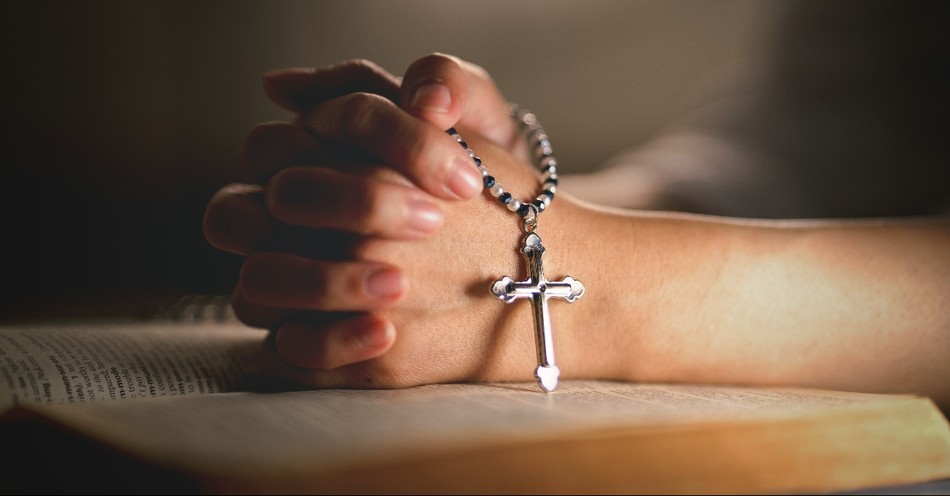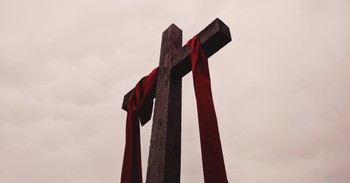Depending on the part of the world you’re in, it may be a common sight or an exceptional sight to see someone ardently clutching rosary beads, head bowed, and eyes lowered as they move their fingers slowly from bead to bead while silently praying the Catholic Rosary.
Praying the Rosary means repeating a set of prayers based on Scripture while meditating on the lives of Jesus and Mary.
What Is the History of the Catholic Rosary?
The practice of keeping track of prayers with the aid of beads or knotted ropes is an ancient tradition that spans several centuries and religions.
Even before the birth of Jesus, it was customary for worshippers across the globe to repeat prayers in a certain pattern and keep count of those prayers with the use of rocks or some other object.
After Christ’s ministry on earth and His glorious Resurrection, St. Paul urged believers to continue praying without ceasing (1 Thessalonians 5:16-18). By the ninth century, monks were reciting all 150 Psalms as part of their daily prayers while keeping count with the use of pebbles.
Christian laypeople sought to imitate this devotion but found it difficult to do so given their high rate of illiteracy.
As a result, laypeople began reciting 150 Our Fathers each week instead of the Psalms. To keep track, they would use knotted string, small pieces of wood, and, eventually, beads.
Catholic tradition holds that the practice of praying the Rosary as we know it today dates back to the 13th century when it is believed that the Virgin Mary appeared to St. Dominic de Guzman in a vision.
At the time, certain heresies existed in Europe denying the Incarnation of Christ, among other Christian doctrines. St. Dominic founded the Order of the Dominicans, which traveled from town-to-town preaching against those heresies.
It was during this time of combatting heresies that Mary appeared to Dominic in France, giving him the Rosary, and instructing the saint to encourage people to pray the Rosary as a way of bringing the fallen a way back to God.
Whether the history of the Catholic Rosary stemmed from ninth-century monks reciting the Psalms or from St. Dominic’s miraculous apparition of Mary, scholars agree that the prayers now recited during the Rosary evolved over the centuries.
Today, a complete recitation of the Catholic Rosary includes the denomination’s most familiar prayers, namely: the Apostles’ Creed, the Our Father, the Hail Mary, the Glory Be, the Fatima Prayer, and the Hail Holy Queen.
What Is the Purpose of the Catholic Rosary?
The purpose of the Catholic Rosary is simple: to teach people about the lives of Jesus and Mary through prayer and contemplation.
Although the purpose of the Rosary is straightforward enough, the biblical events the faithful are asked to focus on are called “mysteries” because they go to the heart of Jesus’ miraculous birth, His ministry and Resurrection, and Mary’s role in salvation history.
The repetition of prayers during the Rosary is meant to block out the noise of our daily lives and encourage us to peacefully reflect on the mystery being prayed over.
Rosaries can be prayed individually in private, as a family at home, or as part of a larger group such as in church before Mass.
The purpose of the rosary beads continues to be to keep track of the pattern of prayers, as well as to give the faithful something to grasp onto in their effort to detach themselves from the stress of today’s world and further ground themselves in prayer.
What Is the Significance of Prayer?
There are many variations of rosary beads. Some are large enough to wear around your neck and others are made to fit around your finger.
When most people think of a Catholic Rosary, they picture the type of rosary that typically consists of 59 beads strung into a loop with a crucifix hanging at the end of the loop.
The crucifix and each bead represent a particular prayer to be said as the person praying positions his or her finger along the length of the beads.
In simplest terms, rosary beads are grouped into five decades, a decade referring to a grouping of ten beads upon which one Hail Mary is prayed for each bead.
Each decade, in turn, is preceded by praying one Glory Be, announcing the mystery (or biblical event) to be meditated upon, and praying the Our Father. A step-by-step explanation of how to pray the Rosary can be found here.
There are four categories of mysteries that Catholics meditate on while praying the Rosary. Each mystery recalls a vivid occurrence in the lives of Jesus and Mary.
There are the Joyful Mysteries, which recall such events as the Annunciation, Mary’s visit with her cousin Elizabeth, and Jesus’ childhood.
There are the Luminous Mysteries, which focus on Jesus’ baptism, His first miracle at Cana, and the institution of the Holy Eucharist. Next are the Sorrowful Mysteries, which focus on Jesus’ Passion.
Last is the Glorious Mysteries, which recall Jesus’ Resurrection, the Assumption of Mary, and the Kingdom of God in heaven.
In the interest of facilitating people’s unified prayer of the Holy Rosary, Pope St. John Paul II recommended that the faithful meditate on the mysteries based on the days of the week.
For example, Catholics can pray the Joyful Mysteries together on Mondays. Likewise, on Tuesdays, the faithful can pray the Sorrowful Mysteries together, and so on for the rest of the week.
Why Is the String of Beads Called a Rosary?
The word “rosary” comes from the Latin word rosarium and means rose garden or garland. Considering that praying the Rosary is an expression of love and fidelity to Jesus Christ, it’s easy to see how some have likened the Rosary to a bouquet of flowers offered to the Lord.
Many have also referred to the Rosary as a form of Bible study on beads. The Rosary takes the faithful on a contemplative journey through the entire New Testament:
Starting with the angel Gabriel’s annunciation to Mary of the virgin birth, moving onto Jesus’ birth, ministry, resurrection, and ascension into heaven, discussing the descent of the Holy Spirit on Christ’s disciples, and ending with Mary’s coronation as queen of heaven and earth.
Why Do Catholics Pray the Rosary?
There’s no obligation for Catholics to pray the Rosary in full, in part, or at all. Yet many Catholics pray the Rosary as a way of focusing on Christ’s sacrifice for humanity while asking for His mother’s prayers as the person closest to Jesus aside from God the Father Himself.
Numerous Catholic families pray the Rosary together at home as a way of teaching their children the faith and nourishing their relationship with God together.
There’s another powerful reason that Catholics pray the Rosary. Given Mary’s unwavering obedience to God and her familiarity with extreme sorrow, many Catholics turn to her in times of doubt and personal tragedy.
In praying the Rosary, Catholics plead for Mary’s intercessory prayers, and end their Rosary devotion with the centuries-old petition that the Blessed Mother “turn, then, O most gracious Advocate, thine eyes of mercy toward us, and…show us the blessed fruit of thy womb, Jesus.”
For further reading:
What Is the Meaning of the Lord's Prayer?
The Glory Be Prayer: Words and Meaning of this Catholic Doxology
What Is the Assumption of Mary? Origins of this Catholic Doctrine
Photo Credit: ©iStock/Getty Images Plus/Mongkolchon Akesin
Dolores Smyth is a nationally published faith and parenting writer. She draws inspiration for her writing from everyday life. Connect with her over Twitter @byDoloresSmyth.



